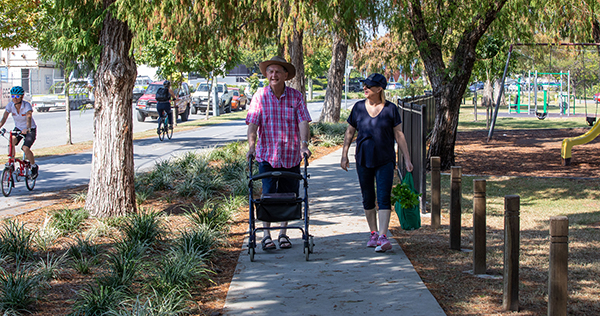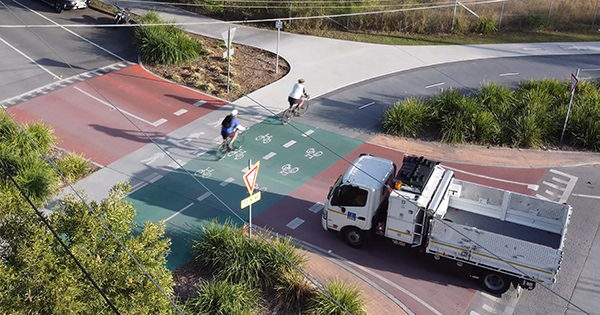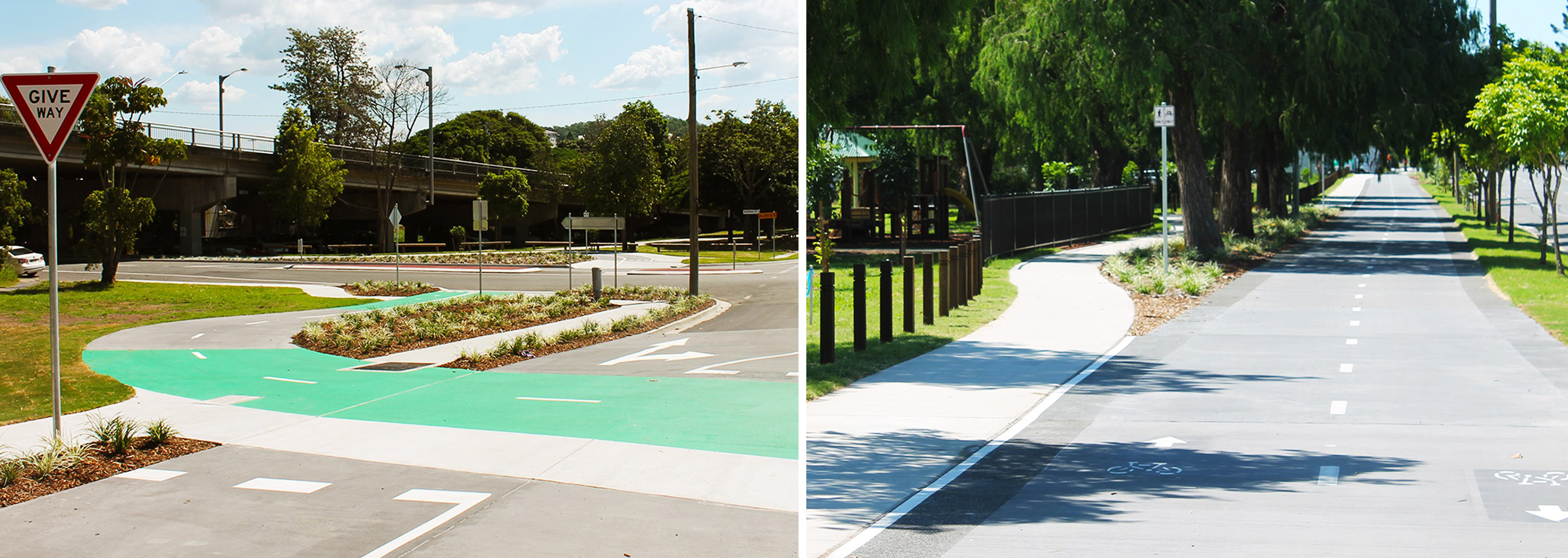North Brisbane Bikeway—Stages 1 to 4
The North Brisbane Bikeway is a major new bike riding corridor for greater Brisbane, connecting Brisbane CBD to Chermside. It addresses a significant gap in bike-riding infrastructure through the northern suburbs of Brisbane.
We have constructed and opened the bikeway in several stages:
- Stage 1 (connecting Herston to Windsor) was completed in 2016
- Stages 2 and 3 were completed in February 2020
- Stage 4 (Rigby Street to Price Street, Wooloowin) opened to pedestrians and bike riders in January 2021.
We used innovative design approaches to deliver a safe off-road connection through a densely populated corridor.

Bike riders and pedestrians using the separated cycle track and footpath near Windsor Park, McDonald Road
Key facts
- 7.5km of continuous bike riding and walking infrastructure from Wooloowin to the Brisbane CBD.
- Features 4.5km of safe separated cycle track and footpath, incorporating priority pedestrian and bike crossings at several intersections.
- The Queensland Government committed $32.11 million for Stages 1 to 4.
Benefits and insights
The North Brisbane Bikeway has improved safety, comfort and amenity by providing pedestrians, bike riders and motorists with separate facilities through this busy northern Brisbane corridor.
The bikeway appears to be encouraging more bike riding and walking by people of all ages and abilities. Anecdotally, there has been good use by families, children and female riders.
We have been collecting evaluation data throughout the project:
- intercept surveys found early stages of the bikeway persuaded people to move from cars and public transport, to walking and riding
- Stage 1B (Federation Street to Somerset Street) created 24% new pedestrian trips
- a counter on Stage 1B at Mann Park in Windsor found the average daily rides on the bikeway increased by 20% in the month following the opening of Stage 3 in 2020.
We are now working with Griffith University and Brisbane City Council to monitor and evaluate changes in usage and safety.
Design innovations and challenges
Retrofitting a separated cycle track into an inner urban setting involved a range of innovations and challenges. The main innovation was the inclusion of several raised priority pedestrian and bike crossings at side roads.

Truck giving way to bike riders using the raised priority crossing on Somerset Street
A raised priority crossing is the continuation of a path across a road where people on the path have priority over vehicles using the road. The facility is designed to optimise the safety of path users by reducing vehicle speeds and making it easier to see people crossing the road. The crossings include raised platforms, coloured markings and signs reinforcing who has priority.
They operate like a pedestrian zebra crossing, giving the people riding and walking priority over motor vehicles at the side road crossings—riders and walkers are provided the same continuous priority as motorists on the nearby primary through road. The raised priority crossings on the North Brisbane Bikeway have been independently evaluated and found to be working well as designed.
Take a journey along the North Brisbane Bikeway and hear from bikeway users about how the raised priority crossings improve safety and comfort.
Show/hide transcript ( /Travel-and-transport/Cycling/Infrastructure-projects/North-Brisbane-Bikeway#video1 )
View the video fullscreen on YouTube
We worked closely with Brisbane City Council to resolve other design challenges, including establishing a short section of one-way street outside Albion Station. This made room for the new bikeway as well as retaining resident parking.

Completed sections of the North Brisbane Bikeway Stages 2 and 3
Community engagement
We undertook significant community consultation during development of the bikeway, including:
- stakeholder and bike riding group briefings
- regular updates to surrounding households and businesses
- flyers and maps along the proposed route.
Feedback from the consultation was overwhelmingly positive and people supported progressing the bikeway further north.
We also engaged closely with local Bicycle User Groups (BUGs) throughout the project design. These BUGs were some of the project's most vocal supporters and advocated for the project throughout design and construction.
Alignment of the North Brisbane Bikeway—Stages 1 to 4
More information
- Read more about Stages 1 to 4 of the North Brisbane Bikeway
- Email the Cycling and Walking team on Cycling_Infrastructure_Program@tmr.qld.gov.au
- Last updated 31 August 2023


